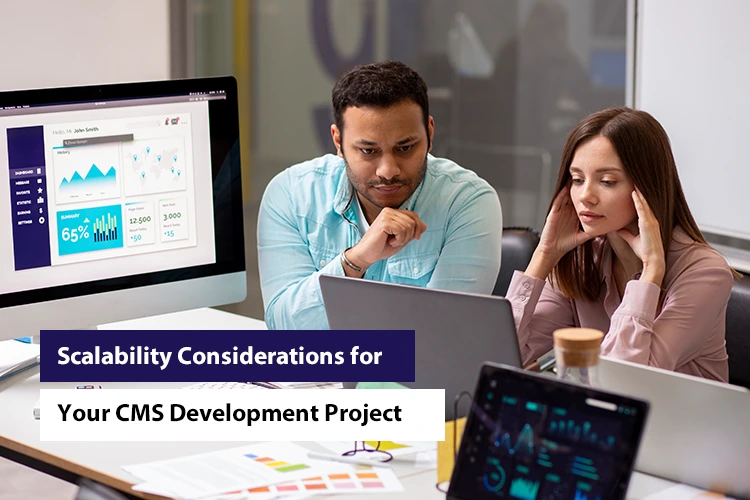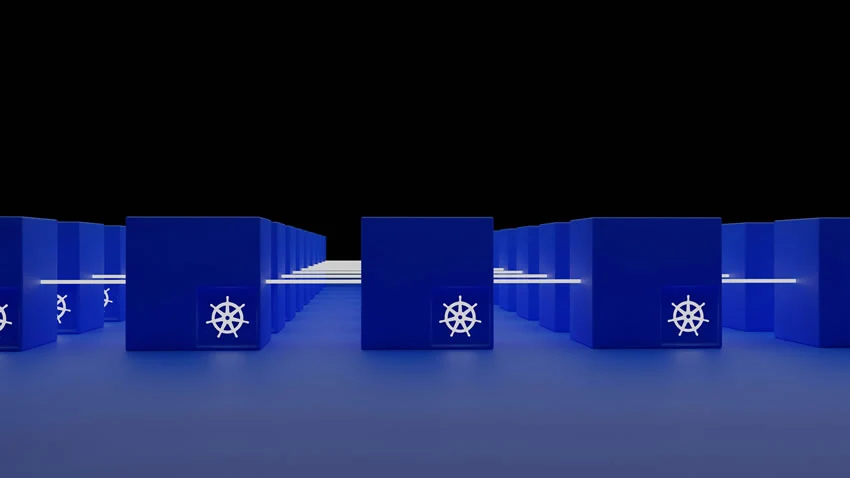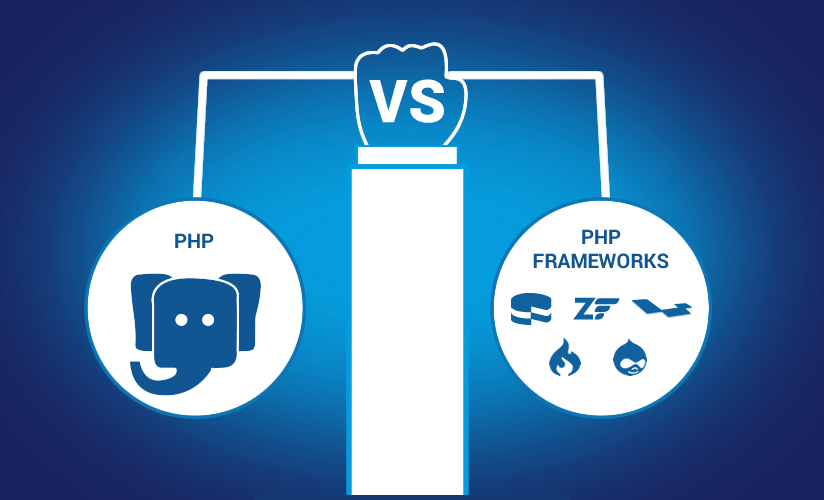Scalability Considerations for Your CMS Development Project

Is your Content Management System (CMS) ready for the future? As the digital landscape continues to evolve at a rapid pace, your website or application’s scalability becomes a make-or-break factor for success. Can your CMS seamlessly accommodate a surge in users, growing content libraries, and sudden traffic spikes?
In the dynamic world of online content, scalability is the key that unlocks endless possibilities. It’s not just about managing today’s requirements but also preparing for what’s on the horizon. Much like building a sturdy foundation for a skyscraper, ensuring your CMS can grow with your ambitions is essential for long-term success.
In this blog, we will discuss the intricacies of scalability for your CMS development project. From the selection of the right technology stack to mastering content distribution and disaster recovery, we’re about to explore the tools and strategies that will help your CMS thrive in an ever-changing digital realm. Let’s dive in!”
Define Your Scalability Requirements
Before embarking on the technical intricacies of building a scalable Content Management System (CMS), it is paramount to establish a clear understanding of your project’s scalability requirements. In essence, this phase serves as the compass that directs your development journey. To achieve this, consider the following essential aspects:
- Expected Growth Rate: It’s imperative to project the growth rate of your content repository and user base. By forecasting how rapidly your CMS will accumulate content and attract users, you gain valuable insights into the magnitude of the scalability challenge ahead. Whether your growth is gradual or exponential, this knowledge sets the stage for the scalability strategy you need to employ.
- Traffic Peaks and Patterns: Recognize any patterns of increased traffic. Do you expect seasonal spikes, promotional campaigns, or other scenarios that will temporarily drive more visitors to your website? Understanding these traffic patterns is crucial, as it enables you to prepare your infrastructure to handle increased loads during these high-demand periods.
- Platform Expansion: If you plan to expand your CMS to cater to different platforms, such as web, mobile apps, or even Internet of Things (IoT) devices, it’s vital to take this into account. Different platforms may have unique requirements, and your CMS must be adaptable to serve content effectively across these various interfaces.
- Geographical Distribution: For projects with a global audience or users scattered across different geographical regions, thinking about geographical distribution is key. This might involve the utilization of Content Delivery Networks (CDNs) and possibly setting up server nodes in different regions to ensure fast content delivery and low latency for users worldwide.
Choose the Right Technology Stack
Selecting the appropriate technology stack is akin to choosing the building blocks of your CMS, and it’s a pivotal decision that can significantly impact your project’s scalability. A well-thought-out technology stack will not only ensure that your CMS functions smoothly but also sets the stage for effective scalability. Here are some considerations when making these critical decisions:
- Database Management: The choice of the database system is paramount. Opt for a database that can efficiently handle your growing datasets. Consider relational databases like MySQL or PostgreSQL for structured data or NoSQL databases like MongoDB or Cassandra if your data structure is more flexible or unstructured. The database is the heart of your CMS, and a robust choice here can greatly influence its overall performance.
- Web Server: Your web server is the bridge between your CMS and the internet. It’s essential to choose a robust and high-performance web server like Apache, Nginx, or LiteSpeed. Each of these options excels in handling a high volume of requests and can be effectively configured for your specific CMS needs.
- Programming Language: The programming language you select is the foundation of your CMS. It’s essential to choose a language with a strong and active developer community and a wealth of scalability options. Popular choices include PHP, Python, Ruby, Node.js, and Java, each with its unique advantages. Your choice will also impact the availability of libraries, frameworks, and third-party tools, all of which contribute to the ease of development and scalability.
- Content Delivery Network (CDN): Implementing a CDN can greatly enhance the performance and scalability of your CMS. CDNs are designed to distribute static content, like images, stylesheets, and JavaScript files, efficiently to users from servers located in various regions. This not only reduces the load on your primary server but also improves user experience by minimizing latency and load times.
Employ Caching Strategies
Caching is a fundamental technique to enhance the performance and scalability of your CMS. It involves storing frequently accessed data in a temporary storage area for rapid retrieval. Employing caching strategies is crucial to reduce the load on your CMS, minimize response times, and provide a seamless user experience. Here’s a deeper look into the various caching mechanisms to consider:
- Page Caching: Page caching involves storing entire web pages so they can be served quickly to users. This technique is highly effective for static or semi-static pages. Popular CMS platforms like WordPress offer plugins that enable page caching, reducing the server’s workload and improving page load times.
- Object Caching: In addition to page caching, consider caching frequently used objects or database queries. For instance, if your CMS frequently retrieves the same data, like user profiles or frequently accessed content, caching these objects can significantly reduce the database load and page rendering time.
- Content Delivery: Utilize Content Delivery Networks (CDNs) to cache and distribute static content, such as images, stylesheets, and JavaScript files. CDNs have servers strategically positioned in different locations worldwide, ensuring users receive content from a server that’s physically closer to them. This not only accelerates content delivery but also reduces the load on your primary server.
- Browser Caching: Browser caching instructs users’ web browsers to store certain files locally. This means that when a user visits your website again, their browser can retrieve files like images or stylesheets from their local cache, rather than downloading them anew from your server. This improves page load times and reduces server load.
- In-Memory Caching: In-memory caching systems like Redis or Memcached can be employed to store frequently used data in server memory. These systems provide rapid access to cached data and are particularly effective for data that needs to be shared across multiple parts of your CMS.
Also Read Our Blog: Cracking the Code: How to Pick the Right CMS for Your Website
Database Optimization

Database optimization is a critical component of building a scalable Content Management System (CMS). A well-structured and optimized database ensures that your CMS can efficiently handle increasing data loads and maintain responsive performance. Here’s a detailed exploration of the key aspects of database optimization:
- Indexing: Indexing is like the table of contents in a book for your database. It allows the database system to quickly locate specific data without having to scan the entire dataset. Proper indexing of tables and columns is essential to optimize query performance. Be strategic in selecting which columns to index, as over-indexing can lead to additional overhead.
- Query Optimization: Database queries are at the heart of CMS operations. Writing efficient SQL queries and optimizing them for your specific database engine is crucial. Pay attention to the selection of fields in SELECT statements, use appropriate WHERE conditions, and consider the use of JOINs and subqueries for complex data retrieval.
- Database Sharding: Sharding involves horizontally partitioning your database into smaller, more manageable parts, called shards. Each shard contains a subset of your data. Sharding can be particularly useful for very large databases, allowing you to distribute data across multiple servers, thereby improving both read and write performance.
- Load Balancing: Implement load balancing to distribute database queries evenly across multiple database servers. Load balancers ensure that no single server is overwhelmed by requests, enhancing both performance and fault tolerance. Balancing strategies can be round-robin, weighted, or based on various algorithms depending on your requirements.
- Connection Pooling: Use connection pooling to efficiently manage and reuse database connections. Opening and closing connections for each query can lead to significant overhead. Connection pooling maintains a set of reusable connections, reducing the time and resources required to establish new connections.
- Normalization and Denormalization: Carefully consider the balance between normalized and denormalized data structures. Normalization reduces data redundancy and maintains data integrity, but it can lead to complex joins and slower query performance. Denormalization simplifies queries by combining data into fewer tables but can increase storage requirements. The choice should align with your specific use cases.
- Database Maintenance: Regularly perform database maintenance tasks such as optimizing table structures, rebuilding indexes, and removing unnecessary data. A well-maintained database operates more efficiently and can contribute to overall system scalability.
- Monitoring and Alerting: Implement database monitoring and alerting systems to keep a close eye on the performance and health of your database. Tools like New Relic, Prometheus, or Grafana provide valuable insights into query performance, resource utilization, and potential bottlenecks.
Horizontal Scaling
Horizontal scaling, often referred to as scaling out, is a key strategy to enhance the performance and scalability of your Content Management System (CMS). It involves adding more servers or resources to your infrastructure to manage increased workloads, accommodate more users, and ensure system reliability. Here’s an in-depth look at the principles and practices of horizontal scaling:
- Load Balancers: Load balancers play a central role in horizontal scaling. These devices distribute incoming traffic evenly across multiple servers, ensuring that no single server is overwhelmed. Load balancing algorithms can be configured to distribute requests based on factors such as server health, capacity, or even user location.
- Server Redundancy: In a horizontally scaled architecture, redundancy is essential to ensure high availability. By deploying multiple servers, you create failover options, which means that if one server experiences a failure, another can seamlessly take over, minimizing downtime.
- Containerization and Orchestration: Technologies like Docker and Kubernetes have revolutionized the way applications are deployed and managed. Containerization allows you to package your CMS and its dependencies into containers, making it easier to scale and deploy across multiple servers or cloud instances. Orchestration tools like Kubernetes simplify the management of containerized applications, automating tasks such as scaling and load balancing.
- Auto-scaling: Auto-scaling is a critical feature of horizontal scaling. With auto-scaling, you set up rules that automatically add or remove resources based on demand. For instance, you might configure your infrastructure to add more servers during periods of high traffic and reduce capacity during quieter times, optimizing resource utilization and cost efficiency.
- Data Partitioning: To support horizontal scaling, you may need to partition your data, separating it into smaller, manageable chunks. Data partitioning strategies include sharding, where data is distributed across different database instances, and partitioning based on user location or other criteria. Effective data partitioning is crucial for maintaining performance as your CMS grows.
- Session Management: Handling user sessions is a challenge in a horizontally scaled environment. You need to ensure that user sessions are maintained across multiple servers. Strategies like sticky sessions or session replication can help maintain user continuity as requests are routed to different servers.
- Centralized Configuration Management: As you scale horizontally, managing configurations across multiple servers becomes complex. Centralized configuration management tools like Consul or etcd allow you to maintain configuration consistency and make updates across all instances simultaneously.
Monitoring and Performance Testing
Monitoring and performance testing are indispensable components of any CMS development project, especially when scalability is a critical concern. These practices help you track your CMS’s health, detect bottlenecks, and fine-tune your system for optimal performance. Here’s a more detailed exploration of these essential activities:
Monitoring
- Real-time Metrics: Implement tools like New Relic, Prometheus, or Grafana to collect and visualize real-time performance metrics. These metrics include server load, response times, error rates, and resource utilization. Monitoring these aspects provides insights into your CMS’s current state, enabling you to identify performance issues promptly.
- Alerting: Set up alerting mechanisms to receive notifications when certain performance thresholds are exceeded. These alerts can help you proactively address issues before they impact the user experience. Common triggers for alerts include high server load, memory usage, or error rates.
- Log Analysis: Analyze server logs to gain a deeper understanding of your CMS’s behavior. Log data can reveal performance bottlenecks, patterns of user behavior, and potential security threats. Log analysis tools like ELK Stack (Elasticsearch, Logstash, Kibana) can be invaluable for this purpose.
- Database Performance Monitoring: Keep a close eye on database performance, monitoring query execution times, index usage, and disk space utilization. Database-specific monitoring tools help in identifying and addressing database-related performance issues.
- User Experience Monitoring: Tools like Google Analytics or similar services provide insights into user behavior and site performance from the user’s perspective. This data helps you understand how real users interact with your CMS and can reveal areas where improvements are needed.
Performance Testing
- Load Testing: Simulate high levels of user traffic to assess how your CMS performs under heavy loads. Load testing tools, such as Apache JMeter or locust.io, help you understand the system’s breaking point and identify potential bottlenecks that may occur during traffic spikes.
- Stress Testing: Go beyond load testing and push your system to its limits. Stress testing helps you discover how your CMS behaves in extreme scenarios. This testing is crucial to ensure your CMS can handle unexpected surges in traffic without crashing or degrading performance.
- Scalability Testing: Specifically test your CMS’s scalability. Simulate scenarios in which you add new servers or resources to your infrastructure to assess how well your system scales. This type of testing helps you fine-tune your auto-scaling rules and ensures your CMS can adapt to changes in demand.
- Performance Profiling: Use profiling tools to identify areas of your CMS code that are causing performance bottlenecks. Profilers help pinpoint which functions or modules are consuming the most resources and taking the most time to execute.
- A/B Testing: A/B testing is a method of comparing two versions of a webpage or feature to determine which one performs better. This testing can help you optimize user experience and content presentation.
Security Considerations

Security is paramount when developing a Content Management System (CMS). A breach can have serious consequences, including data loss, compromised user information, and damage to your brand’s reputation. Therefore, it’s imperative to prioritize security from the very beginning. Here’s an in-depth exploration of the key security considerations for your CMS development project:
- User Authentication and Authorization: Implement robust user authentication mechanisms, including password encryption, multi-factor authentication, and secure password policies. Ensure that users have only the necessary permissions, adhering to the principle of least privilege. Role-based access control (RBAC) can be instrumental in achieving this.
- Data Encryption: Encrypt sensitive data at rest and in transit. Use secure protocols (HTTPS) for data transmission and store sensitive data, such as user credentials, securely hashed and salted in the database. Encrypt data using methods like AES-256 to protect it from unauthorized access.
- Input Validation and Sanitization: Protect your CMS from common vulnerabilities like SQL injection, cross-site scripting (XSS), and cross-site request forgery (CSRF). Input validation and data sanitization are essential to prevent malicious code or input from compromising your system.
- Regular Security Updates: Stay vigilant about software security updates. Ensure that your CMS core, plugins, and libraries are up-to-date to mitigate known vulnerabilities. Implement a routine patch management process.
- Security Headers: Employ security headers such as Content Security Policy (CSP) and HTTP Strict Transport Security (HSTS) to enhance your CMS’s protection against various web vulnerabilities. These headers provide additional layers of defense against cross-site scripting and man-in-the-middle attacks.
- Session Management: Implement secure session management practices to prevent session hijacking and fixation. Use unique session identifiers, employ secure cookie settings, and regularly regenerate session tokens.
- Data Protection and Privacy: Ensure that your CMS complies with data protection and privacy regulations such as GDPR, HIPAA, or CCPA, where applicable. Be transparent with users about data collection and usage practices.
- Security Auditing and Logging: Keep detailed logs of system activities, including user access, authentication attempts, and system changes. Regularly audit these logs for signs of suspicious behavior and maintain an incident response plan in case of a security breach.
- Firewalls and Intrusion Detection Systems (IDS): Utilize firewalls to filter network traffic and intrusion detection systems to detect and respond to potentially malicious activities. These provide an additional layer of security, protecting your CMS from unauthorized access and threats.
- Regular Security Assessments: Conduct regular security assessments and penetration testing to identify vulnerabilities before malicious actors can exploit them. Engage third-party security experts to provide an objective evaluation of your system’s security.
- Security Training and Awareness: Educate your development and administrative teams about security best practices. Promote a culture of security awareness to reduce the risk of human errors that can lead to security breaches.
- Emergency Response Plan: Develop a comprehensive incident response plan to mitigate the impact of potential security breaches. Outline procedures for isolating affected systems, communicating with users, and recovering from an attack.
Content Distribution and Redundancy
Content distribution and redundancy are critical components of a scalable Content Management System (CMS). These strategies ensure that your content is highly available, accessible, and reliable, even in the face of potential failures or fluctuations in demand. Here’s an in-depth look at these vital aspects:
Content Distribution
- Content Delivery Networks (CDNs): CDNs are geographically distributed networks of servers that cache and deliver static content, such as images, stylesheets, and scripts, closer to end-users. Leveraging a CDN can dramatically improve content delivery speed by reducing latency and network congestion. It also lessens the load on your primary server, enhancing scalability and user experience.
- Geographical Content Distribution: In scenarios where your CMS serves a global audience, it’s beneficial to deploy servers or CDN nodes in various geographical locations. This minimizes the physical distance between users and content servers, reducing latency and optimizing the delivery of dynamic content, such as personalized pages or interactive features.
- Edge Computing: Edge computing involves placing servers or processing resources closer to the end-user, at the edge of the network. This architecture reduces the round-trip time for data to travel between the user’s device and the server, resulting in faster response times and improved content delivery. It is particularly useful for dynamic content generation.
Redundancy
- Server Redundancy: Deploying redundant servers ensures high availability. In the event of a server failure, a standby server can take over, minimizing downtime. Redundancy can be achieved through techniques like active-passive or active-active configurations, where multiple servers share the load simultaneously.
- Database Replication: Implement database replication to maintain redundant copies of your database in real time. This can be crucial for ensuring data availability and minimizing data loss in the event of a database server failure. Common replication methods include master-slave replication and master-master replication.
- Failover Mechanisms: Set up automated failover mechanisms that redirect traffic to available resources when a primary server or database fails. These mechanisms ensure continuous service and improve the resilience of your CMS.
- Data Backup and Recovery: Regularly back up your content and data to an off-site location. Implement a robust data recovery strategy that includes scheduled backups, versioning, and data retention policies. This is a critical aspect of disaster recovery and safeguarding your content.
- Content Mirroring: Maintain mirrored copies of content, especially for critical and frequently accessed data. This can involve duplicating content across multiple servers or storage locations, ensuring that users can access content from the nearest, most responsive source.
- Load Balancers: Utilize load balancers not only to distribute incoming traffic but also to monitor server health and respond to failures. Load balancers can automatically redirect traffic to functioning servers, enhancing redundancy and high availability.
- Hot Standby Systems: For real-time redundancy, configure hot standby systems that are ready to take over instantly in the event of a failure. This approach reduces the time it takes to recover from outages and minimizes service disruption.
Disaster Recovery and Backup
Disaster recovery and backup planning are crucial components of any Content Management System (CMS) development project, especially when scalability is a primary concern. These practices ensure the safety and availability of your content and data, protecting your CMS from unforeseen disasters, data loss, or system failures. Here’s an in-depth exploration of these essential aspects:
Backup Strategies
- Regular Backups: Implement a routine backup strategy that regularly saves your CMS data, content, and configurations. Automated backups, scheduled at appropriate intervals, can safeguard against data loss.
- Data Versioning: Utilize data versioning to maintain historical copies of your content and data. This not only aids in recovering lost or modified data but also provides a point-in-time reference for your CMS.
- Off-Site Backups: Store backup copies of your data in off-site locations, away from your primary server or data center. This minimizes the risk of data loss due to physical disasters like fires, floods, or theft.
- Cloud Backups: Consider leveraging cloud storage services for secure, scalable, and cost-effective data backup. Services like Amazon S3, Google Cloud Storage, or Azure Blob Storage offer redundancy and geographic dispersion, making them reliable options for backup storage.
Disaster Recovery Planning
- Disaster Recovery Plan (DRP): Develop a comprehensive disaster recovery plan that outlines procedures to follow in the event of data loss or system failures. A DRP should include steps for data restoration, server replacement, and communications with stakeholders.
- Redundancy and Failover: Maintain redundant systems and failover mechanisms to ensure continuity of service in the event of hardware or software failures. These mechanisms minimize downtime and improve disaster recovery capabilities.
- Geographic Dispersion: Distribute critical resources, such as servers and data centers, across multiple geographical locations. Geographic dispersion reduces the risk of localized disasters affecting all your systems simultaneously.
- Testing and Simulation: Regularly test and simulate disaster scenarios to verify the effectiveness of your recovery plan. Conducting drills helps identify weaknesses and refine your response strategies.
- Data Retention Policies: Define data retention policies to determine how long different types of data should be retained in your backups. Ensure that old or irrelevant data is purged according to these policies.
- Communication Protocols: Establish communication protocols to keep your team informed and coordinated during disaster recovery efforts. Define roles and responsibilities for different team members to facilitate efficient recovery processes.
- Third-Party Services: Consider third-party disaster recovery services that specialize in data recovery, including bare-metal restores and off-site replication. These services can provide expert support in critical situations.
- Documentation and Resources: Maintain detailed documentation of your CMS infrastructure, configurations, and disaster recovery procedures. Ensure that your team has access to these resources during recovery efforts.
Conclusion
Scalability is a fundamental aspect of any CMS development project. By carefully considering your project’s requirements and implementing the right technology, caching, database optimization, and scaling strategies, you can build a CMS that can grow with your needs. Regular monitoring and security measures are essential to ensure that your CMS remains performant and secure as it scales. By following these scalability considerations, your CMS will be well-equipped to handle the demands of a growing audience and evolving content requirements.
Ready to take your CMS to the next level? Imenso Software, our expert partners in CMS development, can help you navigate the intricacies of scalability and build a CMS that’s not just functional but future-proof. Get in touch with Imenso Software today and unlock the true potential of your content management system!
We’re honored to mention that our efforts have been recognized by renowned B2B review and research platforms such as GoodFirms, Clutch, MirrorView, and many more.
Want more information about our services?
Similar Posts

Why MERN Stack is the Best Choice for Your Next Web Development Project
In today’s rapidly evolving digital landscape, choosing the right technology stack for your web development project is crucial. A well-rounded stack should offer efficiency, flexibility, scalability, and a supportive community. Among the various options available, the MERN stack stands out as a powerful and popular choice. Comprising MongoDB, Express.js, React.js, and Node.js, the MERN stack […]...

Building a Competitive Edge with Custom Software Development
Are you tired of treading water while your competitors speed ahead in the digital race? In the ever-accelerating world of business, staying afloat just isn’t enough. To surge ahead, you need a powerful tool – offshore software development. In this blog, we’ll explore how custom software can not only keep you afloat but propel your […]...

Core PHP vs PHP Frameworks
PHP has been a cornerstone of web development for a long time. The LAMP stack (Linux, Apache, MySQL, and PHP) is still a frequently used part of web development, and it is something that people tend to learn in computing courses in college. Today, there are many other frameworks that web applications can be built […]...








